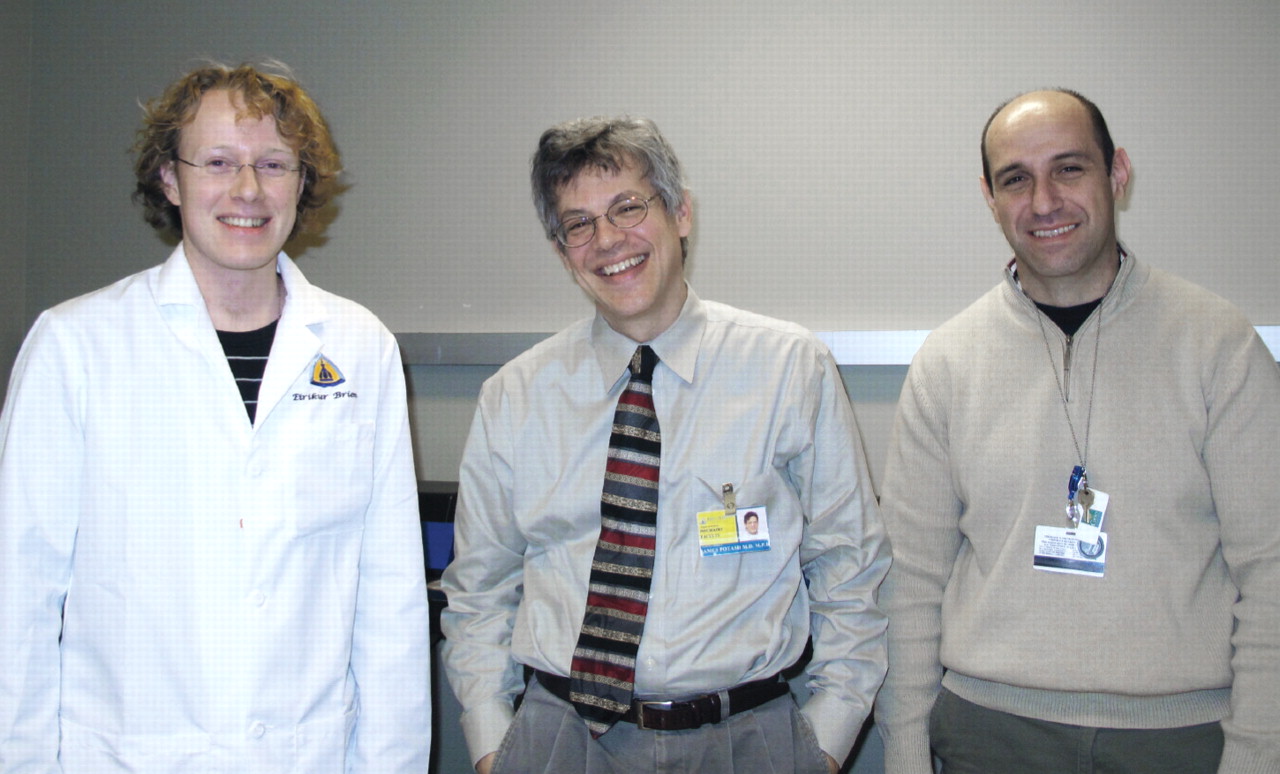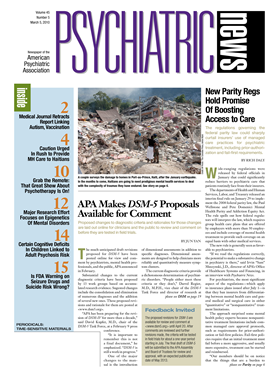Pioneering research in the field of epigenetics, combined with a steady flow of genetic discoveries, is peeling away the layers of complexity around psychiatric disorders and revealing paths to more effective treatment and prevention.
After 20 years of genetic research on psychiatric disorders, scientists have not pinned down a specific genetic cause or risk factor for most patients, even though epidemiological studies have shown that heredity plays a big part in the risk for most mental illnesses. Unlike other diseases that are caused or predisposed by errors in a single gene or a few genes, the molecular basis of psychiatric disorders has turned out to be far more complex.
“Genetics is a very exciting area for research, but in terms of clinical applications,... we are really not there yet,” James Potash, M.D., M.P.H., an associate professor of psychiatry and medicine at Johns Hopkins University (JHU) School of Medicine, told Psychiatric News.
Potash is director of the research program in JHU Hospital's Mood Disorder Center, where genetic research and patient care are combined. He is also an investigator at the university's new Epigenetics Center, which is led by Andrew Feinberg, M.D., a professor of molecular medicine. In 2009, the center received a $16.8 million grant from the NIH to study common human diseases, including cancer, autism, and other psychiatric disorders.
“As of the last two years, however, we've had some robust findings on genes that confer risks in mental illnesses,” said Potash. For example, variations in an area on chromosome 6 were implicated by different research groups for increasing the risk of schizophrenia and bipolar disorder (Psychiatric News, August 7, 2009). Mutations in the ANK3 gene, which codes for the ankyrin G protein and is involved in neurons' sodium channels, are another link to the risk of bipolar disorder and schizophrenia (Psychiatric News, October 3, 2008).
Neuropsychiatric disorders are among the common diseases on which JHU's Epigenetics Center is focusing. “It makes a lot of sense to apply epigenetic research to psychiatry, because epigenetic changes can be induced by environmental factors, and it has long been thought that the environment has something to do with psychiatric illnesses,” said Potash.
Although epigenetics is a young field, its importance is rising quickly and beginning to rival genetic research. Scientists have long realized that not all genes are expressed into corresponding proteins in every cell all the time. The expression of any given gene is activated or shut off in different cells. In other words, a person may carry a particular gene, but if the gene is “silenced,” the body may not make any protein from the gene and, in turn, not present the related trait.
Scientists have found several ways in which gene transcription and expression can be altered, including DNA methylation and histone modification. Histones make up the protein “beads” that DNA is wrapped around, and the shape of this wrapping can determine which parts of DNA are accessible for transcription. The epigenetic regulation of gene expression explains why humans are far more complex than the sum of all their genes.
More intriguingly, epigenetic markers on DNA can be influenced by environmental forces, such as smoking, diet, and pollutants. These changes are maintained through cell divisions and can last a lifetime. Research on identical twins has shown that the extent of DNA methylation is highly correlated between both twins when they are young, but the correlation becomes a lot weaker when they age. “It suggests that things that happen in a lifetime can cause divergence in epigenetics,” said Potash.
In other words, epigenetics is the place where nature and nurture converge. The genes we are born with can determine some but not all of who we are and who we become.
Fishing for Clues in Epigenome
Researchers at the JHU Epigenetics Center developed a tool to scan the genome and measure DNA methylation in various genes using a microarray chip called CHARM, which stands for comprehensive high-throughput arrays for relative methylation. Each microarray chip can simultaneously study 40,000 regions in a genome to describe which genes are methylated and thus suppressed.
The CHARM microarrays scan the epigenome to find out which genes are expressed and which are not, Eirikur Briem, M.S., manager of the Epigenetics Center's microarray laboratory, explained.
Like the way DNA microarrays made genomewide scanning possible, the CHARM microarray chips allow researchers to map DNA methylation patterns quickly in millions of genes.
“Genomewide scans allow us to look at the whole genome rather than one gene at a time; this [CHARM microarray] is a platform for us to pick up things that we had no idea about,” said Potash. Thus, researchers need not confine their hunt for disease-related genes and proteins to the usual suspects: dopamine, serotonin, brain-derived neurotrophic factor, or norepinephrine. Unexpected pathways may be discovered.
Real-Time Snapshot of Gene Expression
The center has received funding to conduct a “gigantic schizophrenia study,” Potash said with a hint of pride. He and his colleagues will compare patients, their family members, and control subjects without schizophrenia for distinct epigenetic differences in hopes of identifying genetic expressions or suppressions involved in the disorder.
A big hurdle in studying epigenetic markers is choosing what tissue to study. Unlike genetic material, which is the same in nearly all cells throughout the body, the epigenetic pattern differs by tissue.
Potash pointed to a study he and his colleagues published in Nature Genetics in February 2009 in which they applied CHARM testing to brain, liver, and spleen tissue. “The study shows clearly that DNA methylation patterns differ a lot among the three types of tissues,” he said. “In fact, the DNA methylation patterns in the human brain are more like the patterns in mouse brain than the patterns in the human liver or human spleen.”
In the ongoing schizophrenia epigenetics study, Potash and colleagues decided to use white blood cells for analysis, because it is extremely difficult to obtain brain tissue from a living person, not to mention hundreds of people. “If we find clear differences [between patients and controls], that is going to be interesting anyway... [because] some of the epigenetic differences are also reflected in the brain,” said Potash. As insurance, they also plan to examine postmortem brain tissues of patients with schizophrenia to corroborate the findings from the blood analysis.
Furthermore, “Whatever differences show up in blood, if replicated, could be used as a marker for the disease,” Potash said.
Prediction, Prevention Poised to Advance
Potash cautioned against unrealistic expectations that this type of research can revolutionize medicine overnight and find a cure for every illness. He does believe, however, that the discoveries will move psychiatry forward in long strides. For example, research will help psychiatrists predict, even quantify, a person's risk for developing a mental illness based on his or her genetic markers, according to Potash. With the help of further clinical evidence, individuals at high risk who do not meet diagnostic criteria can be targeted for prevention measures, thus staving off psychiatric disorders before they take shape.
Second, genetics can help clinicians predict who will respond to which drug and choose the best treatment for each patient. Lastly, understanding the pathophysiology of psychiatric disorders will help neurobiologists and pharmacologists design new drugs that work more effectively with fewer side effects.


